Current operational fire behavior models are empirically based on fire spread through surface fuels and do not describe heating and combustion processes. Current physical models describe fire spread processes; however, the fire spread processes of heat exchange and ignition are assumed without an experimental basis. FFS researchers and collaborators have developed a program of research for understanding how fire spread occurs with a focus on live fuels and active crown fire. Specific fire dynamics research investigations include:
- Fuel particle heat exchange
- Live vegetation thermal decomposition processes
- Non-steady flame structure
- Flame source burning duration
Please see the Downloads & Users Guide section for videos of our experiments.
Image: Convection heat transfer requires flames to contact adjacent fuels. Discontinuous fuels (e.g. shrub and tree canopies) require flames to extend across gaps between fuel clusters. The vertical flame wall with its high sample rate heat flux sensors (shown) and thermocouples are used to describe flame turbulence and thus the flame position and duration. Diffusion flames are produced using buoyantly neutral ethylene fuel gas.
